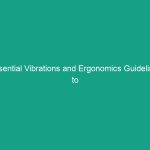Introduction
In today’s world, the importance of health, safety, and environmental (HSE) standards cannot be overstated. As industries expand and evolve, ensuring Workplace Safety and minimizing environmental impact has become a critical focus for organizations globally. Environmental Safety standards not only serve to protect workers and the Environment but also help organizations comply with legal Regulations and enhance their reputations. This article will delve into essential guidelines regarding environmental Safety Standards, highlighting their significance, frameworks, and Best Practices that facilitate compliance.
Understanding Environmental Safety Standards
Environmental safety standards refer to the regulations and guidelines that govern how industries should operate to minimize their environmental impact. These standards are designed to protect both the environment and human health, ensuring that companies adhere to practices that reduce waste, prevent pollution, and promote Sustainability. Compliance with these standards is not just a legal obligation; it is also a moral responsibility that organizations must embrace to ensure a safe and healthy working environment.
The Importance of Compliance
Compliance with environmental safety standards is crucial for several reasons. Firstly, it protects the health and safety of employees and the surrounding community. Secondly, it helps organizations avoid legal penalties and fines that can arise from non-compliance. Lastly, companies that demonstrate a commitment to environmental safety often enjoy enhanced public trust and improved relationships with stakeholders. By prioritizing compliance, organizations can achieve operational excellence while contributing to a sustainable future.
Regulatory Frameworks Governing Environmental Safety Standards
Understanding the regulatory frameworks that shape environmental safety standards is essential for compliance. Various national and international organizations develop guidelines and regulations that industries must follow. Here are some of the key regulatory bodies and frameworks influencing environmental safety standards:
International Standards Organization (ISO)
The ISO develops and publishes international standards that ensure the quality, safety, and efficiency of products, services, and systems. ISO 14001 is particularly relevant for environmental management systems, providing organizations with a framework to manage their environmental responsibilities systematically.
Occupational Safety and Health Administration (OSHA)
In the United States, osha sets and enforces standards to ensure safe and healthy working conditions. OSHA regulations often overlap with environmental safety standards, especially in industries where hazardous materials are handled. Compliance with OSHA regulations can significantly reduce workplace accidents and enhance overall safety.
Environmental Protection Agency (EPA)
The EPA is responsible for regulating environmental laws in the U.S. It implements regulations that control pollution and protect natural resources. Organizations must comply with EPA standards to avoid penalties and contribute to environmental conservation.
European Union Regulations
In Europe, various directives and regulations, such as REACH (Registration, Evaluation, Authorisation, and Restriction of Chemicals), govern the safe use of chemicals and their impact on health and the environment. Understanding these regulations is vital for companies operating within the EU or exporting to this market.
Best Practices for Compliance with Environmental Safety Standards
Implementing Best Practices is crucial for ensuring compliance with environmental safety standards. Here are some essential practices that organizations can adopt:
Conducting Regular Audits
Regular audits are a fundamental aspect of compliance. Organizations should conduct internal audits to assess their adherence to environmental safety standards. These audits help identify areas of non-compliance and provide opportunities for improvement, ensuring that companies remain accountable for their environmental impact.
Employee Training and Awareness
Training employees on environmental safety standards is vital for fostering a culture of compliance. Organizations should provide regular training sessions that educate employees about their roles in maintaining safety and compliance. By empowering employees with knowledge, organizations can enhance their commitment to environmental safety.
Implementing a Management System
Establishing an environmental management system (EMS) based on ISO 14001 can help organizations systematically manage their environmental responsibilities. An EMS provides a structured approach to identifying, managing, and mitigating environmental risks, ensuring long-term compliance with environmental safety standards.
Engaging with Stakeholders
Engaging with stakeholders, including employees, customers, and local communities, is essential for transparency and accountability. Organizations should communicate their environmental policies and practices, inviting feedback and collaboration to enhance their compliance efforts. This engagement fosters trust and encourages shared responsibility for environmental protection.
Monitoring and Reporting
Consistent monitoring and reporting of environmental performance are critical for compliance. Organizations should establish key performance indicators (KPIs) to track their environmental impact and progress towards sustainability goals. Transparent reporting can enhance accountability and demonstrate a commitment to environmental safety standards to stakeholders.
Case Studies: Successful Compliance with Environmental Safety Standards
Real-world examples can provide valuable insights into how organizations have successfully navigated compliance with environmental safety standards. Here are a few notable case studies:
Case Study 1: Toyota
Toyota has been recognized for its commitment to environmental sustainability and compliance with safety standards. The company implemented an EMS that aligns with ISO 14001, enabling it to systematically manage its environmental impact. Through continuous improvement initiatives, Toyota reduced its carbon emissions significantly and enhanced its resource efficiency.
Case Study 2: Unilever
Unilever is another example of a company that has prioritized environmental safety standards. The company has set ambitious sustainability goals, including reducing its waste and carbon footprint. By engaging with suppliers and stakeholders, Unilever has successfully implemented sustainable practices throughout its supply chain, demonstrating a strong commitment to environmental compliance.
Case Study 3: BP
Following the Deepwater Horizon oil spill, BP undertook extensive reforms to enhance its compliance with environmental safety standards. The company invested significantly in improving its safety culture, implementing rigorous training programs, and establishing a comprehensive EMS. These efforts have helped BP restore its reputation and demonstrate a commitment to environmental stewardship.
Challenges in Achieving Compliance
While organizations strive to comply with environmental safety standards, they often face several challenges. Recognizing these obstacles is crucial for developing effective strategies to overcome them:
Complex Regulatory Landscape
The regulatory landscape surrounding environmental safety standards can be complex and ever-changing. Organizations may struggle to keep up with new regulations and amendments, leading to potential non-compliance. Staying informed about regulatory changes and seeking expert advice can help organizations navigate this complexity.
Resource Constraints
Many organizations, particularly small and medium-sized enterprises (SMEs), may lack the resources to implement comprehensive compliance programs. Limited budgets and personnel can hinder their ability to conduct audits, provide training, or invest in an EMS. Finding cost-effective solutions and leveraging technology can help SMEs overcome these resource constraints.
Cultural Resistance
Creating a culture of compliance can be challenging, especially in organizations where safety and environmental practices have not been prioritized. Resistance to change among employees can impede the adoption of new practices. Organizations should focus on fostering a culture of safety through leadership commitment, employee involvement, and ongoing education.
Future Trends in Environmental Safety Standards
The landscape of environmental safety standards is continually evolving. Here are some key trends that organizations should watch for in the future:
Increased Focus on Sustainability
As climate change and environmental degradation become more pressing issues, organizations are increasingly focusing on sustainability. Future environmental safety standards will likely emphasize sustainable practices, encouraging companies to adopt renewable energy sources, reduce waste, and promote circular economy principles.
Technological Advancements
Technology will play a crucial role in shaping the future of environmental safety standards. Innovations such as artificial intelligence, blockchain, and the Internet of Things (IoT) can enhance monitoring, reporting, and compliance efforts. Organizations that leverage technology effectively will be better positioned to meet evolving standards and expectations.
Greater Stakeholder Engagement
Stakeholder engagement will become increasingly important as organizations strive for transparency and accountability. Companies will need to collaborate with various stakeholders, including customers, communities, and regulators, to develop and implement effective environmental safety standards. Engaging stakeholders in decision-making processes can enhance compliance and foster trust.
Conclusion
Compliance with environmental safety standards is essential for organizations seeking to protect human health and the environment while achieving operational excellence. By understanding the regulatory frameworks, implementing best practices, and learning from successful case studies, companies can navigate the complexities of environmental compliance effectively. As the landscape continues to evolve, organizations must remain proactive in adapting to new challenges and trends. Embracing environmental safety standards is not only a legal obligation but also a pathway to sustainability and corporate responsibility. Take action today to ensure that your organization prioritizes environmental safety and compliance.


